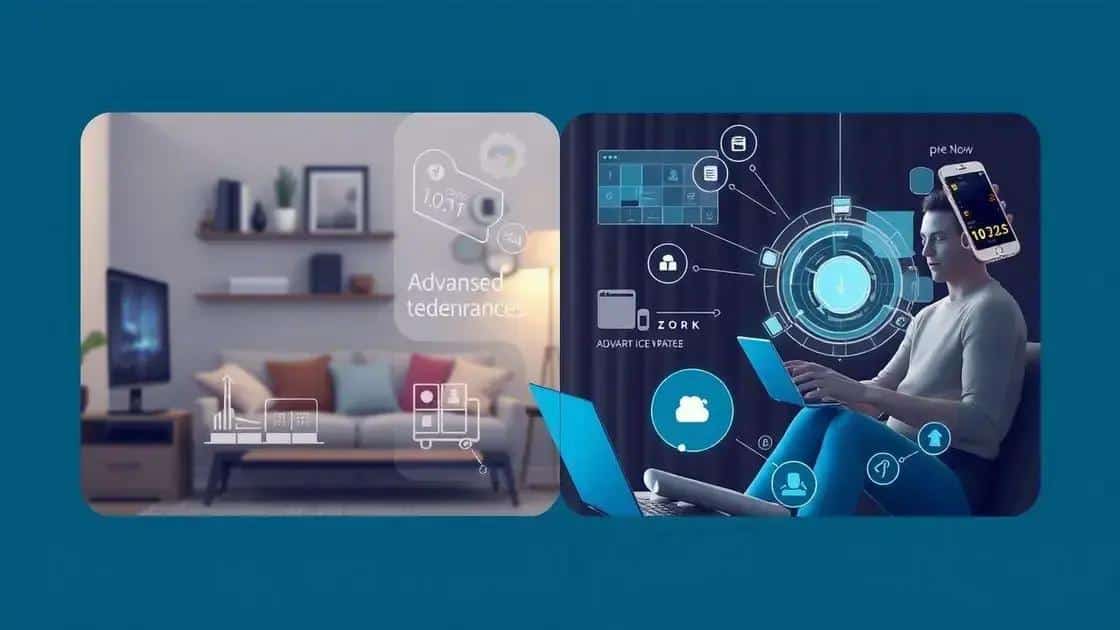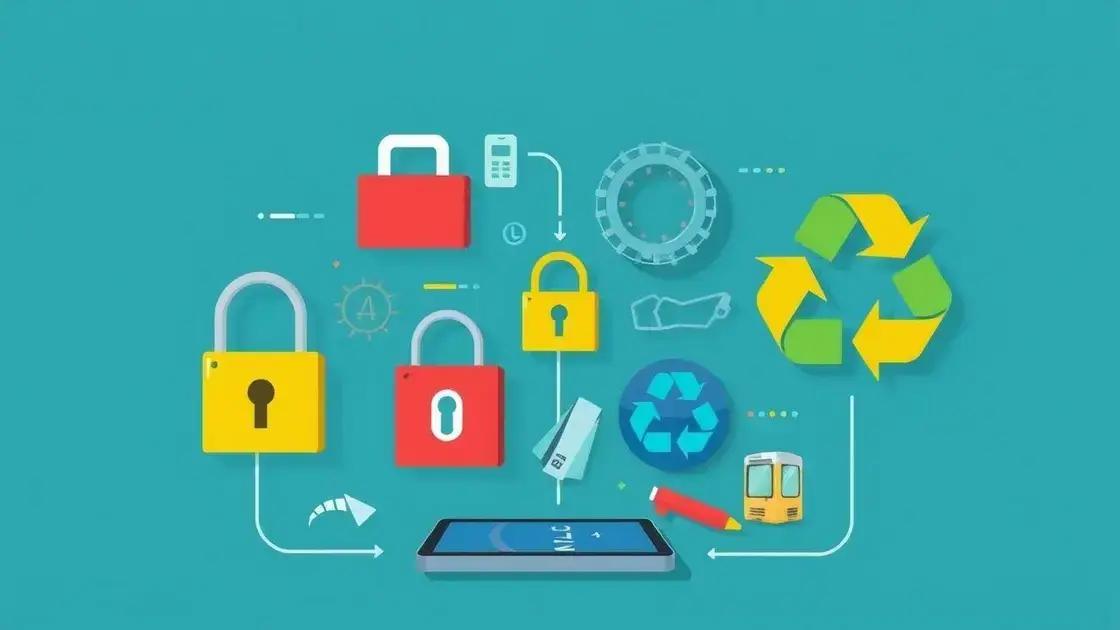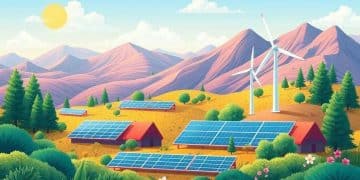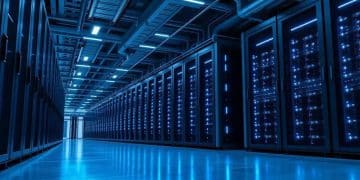Consumer tech releases 2025 trends: what’s coming

Consumer technology trends in 2025 will focus on innovations like AI integration, smart devices, and sustainable practices, while facing challenges related to data privacy, environmental impact, and cybersecurity threats.
Consumer tech releases 2025 trends are set to redefine how we interact with technology. As innovation accelerates, new gadgets and advancements promise to enhance our daily lives. Curious about what’s on the horizon?
Key innovations to watch in consumer tech
Exciting key innovations are emerging in consumer tech, set to transform our experiences in 2025. New gadgets and systems will enhance efficiency and connectivity.
Artificial Intelligence in Everyday Devices
As AI continues to evolve, we will see it integrated into more everyday devices. From smart home assistants to personal health monitors, these innovations will help automate tasks and provide personalized experiences.
Augmented Reality and Virtual Reality
Augmented Reality (AR) and Virtual Reality (VR) are becoming more mainstream. Expect devices that allow immersive experiences for gaming or virtual meetings, bridging gaps in communication and entertainment.
5G Technology
The rollout of 5G networks will revolutionize connectivity. This technology allows for faster download speeds and more reliable connections, making smart devices work seamlessly.
- Enhanced streaming quality
- IoT devices with real-time data access
- Greater capacity for simultaneous connections
As we look deeper into innovations, the focus on sustainability is also growing. Tech companies are prioritizing eco-friendly practices in their manufacturing and development processes, ensuring that new products are both high-performing and environmentally responsible.
In addition to physical products, software innovations are on the rise. Enhanced apps for smart devices offer users more features, improving usability and integration across platforms. Expect apps to leverage data smarter, providing proactive solutions to everyday challenges, and increasing user engagement.
Health Tech Advances
Another area to watch is health technology. Wearable devices will become more sophisticated, providing real-time health monitoring that can alert users and healthcare professionals of potential issues before they become critical.
- Improved biometric sensors
- Data-sharing capabilities with healthcare providers
- Integration with fitness tracking systems
The future of consumer tech is bright and full of potential. As we navigate through 2025, these innovations will not only reshape our relationship with technology but also improve our quality of life, making everyday tasks easier and more enjoyable.
Impact of upcoming technologies on daily life

The impact of upcoming technologies on daily life is profound. As new innovations emerge, they reshape how we interact with the world around us.
Enhanced Connectivity
With advancements like 5G, our devices will connect faster and more reliably. This means smoother video calls, quicker downloads, and instant access to cloud services.
Smart Home Integration
Smart home devices are becoming increasingly common. They allow users to control lighting, heating, and security systems remotely, making life more convenient and efficient.
- Automated energy management
- 24/7 home monitoring
- Easier personalization of home environments
This level of integration not only promotes comfort but also enhances energy savings, contributing to a more sustainable lifestyle.
Moreover, wearable technology is playing a crucial role in personal health management. Devices like smartwatches monitor our physical activity and health metrics, offering insights that encourage healthier habits.
Transforming Work Environments
As telecommuting becomes the norm, technologies that facilitate remote work are vital. Collaboration tools and video conferencing software help teams stay connected, no matter where they are.
- Improved team collaboration
- Access to global talent
- Flexibility in work hours
This shift is not just about convenience; it also allows for a better work-life balance, which can lead to increased productivity and job satisfaction.
In addition to these benefits, the rise of AI and machine learning will streamline tasks across various industries. Businesses will automate repetitive tasks, allowing employees to focus on more engaging and creative work. This transformation could significantly improve job satisfaction as people take on more meaningful roles.
The overall impact of these technologies will be to create a more connected, efficient, and balanced lifestyle. Embracing these advancements can lead to a more sustainable future.
Sustainable tech trends in 2025
Sustainable tech trends in 2025 will redefine how we interact with the environment. As awareness of climate change grows, technology companies are adapting to create products that are not only innovative but also eco-friendly.
Green Energy Solutions
Future technologies will heavily focus on renewable energy. Solar panels and wind turbines will become more efficient, making clean energy more accessible.
Eco-friendly Materials
Manufacturers are increasingly using sustainable materials in their products. Expect to see devices made from biodegradable plastics and recycled metals, reducing the overall carbon footprint.
- Smart recycling systems
- Compact renewable energy devices
- Biodegradable packaging for electronics
This shift not only indicates a change in product design but also a broader commitment to reduce waste and conserve resources.
Moreover, companies are adopting sustainable practices in their operations. This includes reducing energy consumption in production and logistics, leading to a smaller environmental impact. By implementing these practices, brands can attract eco-conscious consumers.
Energy-efficient Devices
As technology advances, the development of energy-efficient devices will become a priority. Gadgets that use less power while providing the same functionalities will dominate the market.
- Smart home devices that optimize energy use
- Energy-saving appliances with better performance
- Low-energy computing solutions
The rise of circular economy principles will also reshape production strategies. This approach focuses on designing products that are easy to repair, reuse, and recycle, minimizing waste in the long run.
In conclusion, embracing sustainable tech trends in 2025 will benefit both the environment and consumers. These innovations promise to make life better while maintaining the health of our planet.
Anticipated challenges in consumer technology

The anticipated challenges in consumer technology are numerous as we approach 2025. As technology evolves, so do the complexities of integrating it into daily life.
Data Privacy Concerns
One major challenge is data privacy. With the increase in smart devices, more personal information is collected. Users may worry about how their data is used and who has access to it.
Dependence on Technology
Another challenge is the growing dependence on technology. As more tasks become automated, people may struggle with basic skills. This reliance can lead to difficulties in situations where technology fails or is unavailable.
- Risk of decreased problem-solving abilities
- Increased anxiety during technology outages
- Loss of personal connections due to virtual communication
This dependence can result in a disconnect from reality, where individuals might prioritize their devices over personal interactions.
Environmental Impact
Consumer technology also faces scrutiny regarding its environmental impact. As devices become more advanced, they require more resources for production and energy to operate.
- Electronic waste management issues
- Increased carbon footprint from manufacturing
- Pressure for sustainable practices in tech production
Companies need to adopt greener practices to minimize their environmental footprints and address consumer concerns about sustainability.
Aside from these issues, the fast pace of innovation can leave consumers feeling overwhelmed. New technologies often come with steep learning curves, especially for older generations. Ensuring that everyone can adapt and benefit from technological advances is a challenge that companies must tackle by providing education and support.
Finally, cybersecurity threats are also a persistent challenge. As more devices are connected to the internet, the risk of hacking and data breaches increases. Businesses must invest significantly in security measures to protect user information.
In conclusion, the future of consumer technology in 2025 promises exciting innovations alongside significant challenges. As we embrace new devices and systems, issues like data privacy, environmental impact, and reliance on technology will be critical to address. The industry must work to ensure that advancements benefit everyone while minimizing their drawbacks. Awareness of these challenges is key to navigating the evolving tech landscape.
\n\n\n
\n
\n
FAQ – Frequently Asked Questions about Consumer Technology Trends
What are the main challenges facing consumer technology in 2025?
The main challenges include data privacy concerns, increasing dependence on technology, environmental impact, and cybersecurity threats.
How will data privacy affect consumer technology?
As more devices collect personal data, consumers will worry about who has access to their information and how it’s being used.
What role does sustainability play in future technology?
Sustainability will be a key focus, with tech companies seeking to create eco-friendly products and reduce their environmental footprint.
How can consumers prepare for rapid technology changes?
Consumers can stay informed about new technologies and educate themselves on how to use them effectively to avoid feeling overwhelmed.





